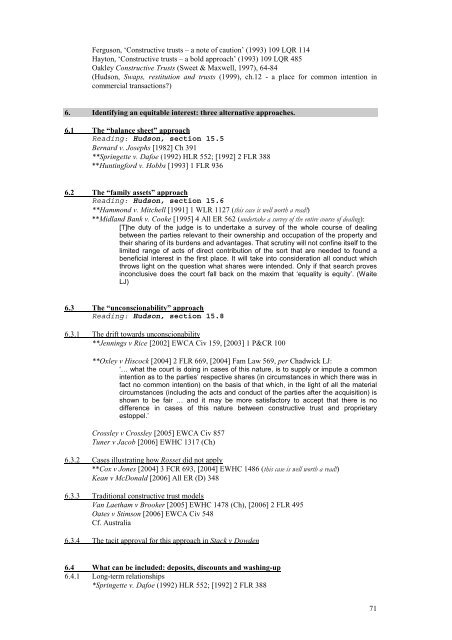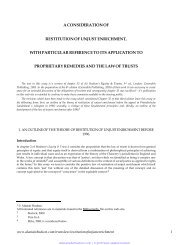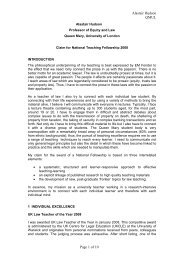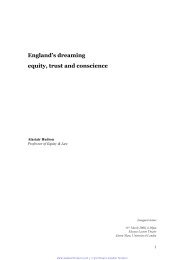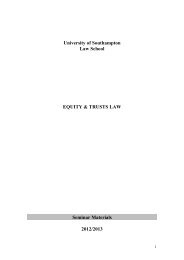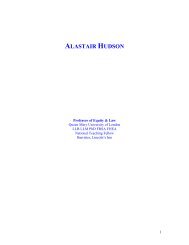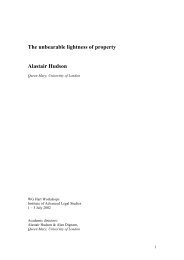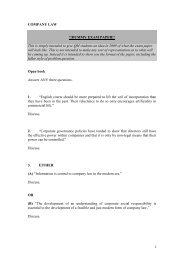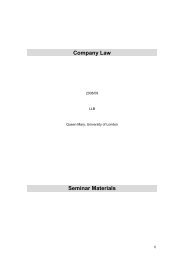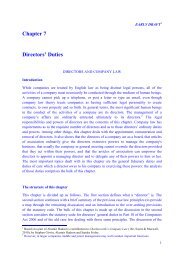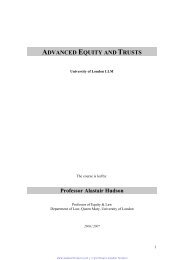Soton Equity and Trusts - alastairhudson.com
Soton Equity and Trusts - alastairhudson.com
Soton Equity and Trusts - alastairhudson.com
You also want an ePaper? Increase the reach of your titles
YUMPU automatically turns print PDFs into web optimized ePapers that Google loves.
Ferguson, ‘Constructive trusts – a note of caution’ (1993) 109 LQR 114<br />
Hayton, ‘Constructive trusts – a bold approach’ (1993) 109 LQR 485<br />
Oakley Constructive <strong>Trusts</strong> (Sweet & Maxwell, 1997), 64-84<br />
(Hudson, Swaps, restitution <strong>and</strong> trusts (1999), ch.12 - a place for <strong>com</strong>mon intention in<br />
<strong>com</strong>mercial transactions?)<br />
6. Identifying an equitable interest: three alternative approaches.<br />
6.1 The “balance sheet” approach<br />
Reading: Hudson, section 15.5<br />
Bernard v. Josephs [1982] Ch 391<br />
**Springette v. Dafoe (1992) HLR 552; [1992] 2 FLR 388<br />
**Huntingford v. Hobbs [1993] 1 FLR 936<br />
6.2 The “family assets” approach<br />
Reading: Hudson, section 15.6<br />
**Hammond v. Mitchell [1991] 1 WLR 1127 (this case is well worth a read!)<br />
**Midl<strong>and</strong> Bank v. Cooke [1995] 4 All ER 562 (undertake a survey of the entire course of dealing):<br />
[T]he duty of the judge is to undertake a survey of the whole course of dealing<br />
between the parties relevant to their ownership <strong>and</strong> occupation of the property <strong>and</strong><br />
their sharing of its burdens <strong>and</strong> advantages. That scrutiny will not confine itself to the<br />
limited range of acts of direct contribution of the sort that are needed to found a<br />
beneficial interest in the first place. It will take into consideration all conduct which<br />
throws light on the question what shares were intended. Only if that search proves<br />
inconclusive does the court fall back on the maxim that ‘equality is equity’. (Waite<br />
LJ)<br />
6.3 The “unconscionability” approach<br />
Reading: Hudson, section 15.8<br />
6.3.1 The drift towards unconscionability<br />
**Jennings v Rice [2002] EWCA Civ 159, [2003] 1 P&CR 100<br />
**Oxley v Hiscock [2004] 2 FLR 669, [2004] Fam Law 569, per Chadwick LJ:<br />
‘… what the court is doing in cases of this nature, is to supply or impute a <strong>com</strong>mon<br />
intention as to the parties’ respective shares (in circumstances in which there was in<br />
fact no <strong>com</strong>mon intention) on the basis of that which, in the light of all the material<br />
circumstances (including the acts <strong>and</strong> conduct of the parties after the acquisition) is<br />
shown to be fair … <strong>and</strong> it may be more satisfactory to accept that there is no<br />
difference in cases of this nature between constructive trust <strong>and</strong> proprietary<br />
estoppel.’<br />
Crossley v Crossley [2005] EWCA Civ 857<br />
Tuner v Jacob [2006] EWHC 1317 (Ch)<br />
6.3.2 Cases illustrating how Rosset did not apply<br />
**Cox v Jones [2004] 3 FCR 693, [2004] EWHC 1486 (this case is well worth a read!)<br />
Kean v McDonald [2006] All ER (D) 348<br />
6.3.3 Traditional constructive trust models<br />
Van Laetham v Brooker [2005] EWHC 1478 (Ch), [2006] 2 FLR 495<br />
Oates v Stimson [2006] EWCA Civ 548<br />
Cf. Australia<br />
6.3.4 The tacit approval for this approach in Stack v Dowden<br />
6.4 What can be included: deposits, discounts <strong>and</strong> washing-up<br />
6.4.1 Long-term relationships<br />
*Springette v. Dafoe (1992) HLR 552; [1992] 2 FLR 388<br />
71


